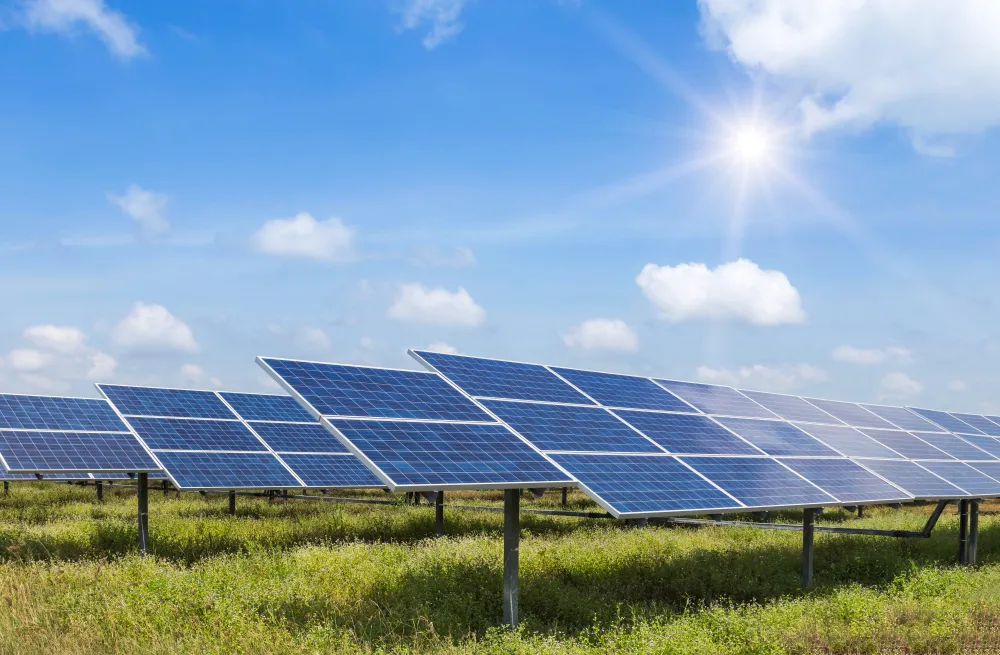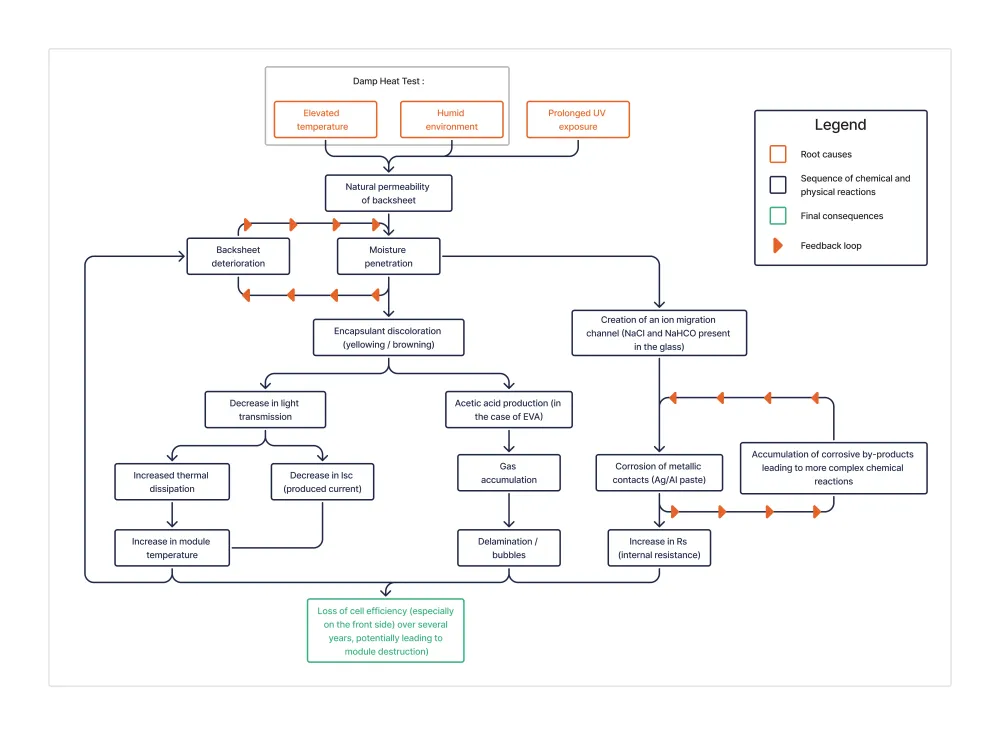New type of degradation on TOPCon
TOPCon Technology (Tunnel Oxide Passivated Contact) has gradually established itself as the dominant technology in the photovoltaic market, driven by significant advancements in conversion efficiency and economic competitiveness. However, this rise in popularity is accompanied by growing concerns regarding the long-term reliability of TOPCon modules, particularly in hot and humid environments.
Recent studies highlight the increased sensitivity of the front side of TOPCon cells to corrosion, exacerbated by exposure to contaminants from the glass, such as NaCl or NaHCO₃. These contaminants can be present from the manufacture of the glass (AR layers / soda-lime glasses) or penetrate on site (via dust / pollutants / sea air). Accelerated aging tests (such as "Damp Heat") reveal a significant increase in series resistance, resulting in substantial power losses and compromising the durability of the modules. Several approaches, including laser-assisted metallization or the use of new low-aluminum screen-printing pastes, are being explored to enhance the resilience of cells against external aggressions.
Simultaneously, the choice of encapsulation materials and module structure (glass/backsheet vs. bifacial glass) plays a key role in preserving the performance of TOPCon modules. While traditional polymer backsheets (PET, polyolefin) offer appreciable lightness and flexibility, they expose cells to increased risks of degradation due to humidity and corrosive by-products like acetic acid, resulting from EVA degradation. Conversely, bifacial glass modules, although heavier, demonstrate better resistance to moisture infiltration and chemical aggressions, thereby extending the lifespan of photovoltaic systems.
In this context, the question of optimizing TOPCon module design remains open: how can we balance performance, cost, and reliability to ensure a sustainable technological transition? This challenge requires a thorough analysis of the interactions between metallization, encapsulation, and operating environment to guide the development of robust and durable solutions for the next generation of photovoltaic modules.
To better understand the degradation mechanisms involved, a diagram detailing the root causes, the sequence of chemical and physical reactions, and their final consequences on the performance of photovoltaic panels is presented below:
Encapsulant
The choice of encapsulant plays a determining role in the degradation process. Here is a quick comparison of its effects on degradation and the impact on energy production :
EVA (Ethylene-vinyl acetate) :
● Release of acetic acid causing cell corrosion, an increase in series resistance, and a loss of generated power.
POE (Polyolefin elastomer) :
● Chemically stable, meaning no release of acetic acid with resistance to hydrolysis and oxidation.
TPO (Thermoplastic polyolefin) :
● Chemically stable, meaning no release of acetic acid with resistance to hydrolysis and oxidation.
EVA (Ethylene-vinyl acetate) :
● Lower generated power due to low UV region transmission (only 31%).
● Significant degradation in the long term leads to a decrease in energy efficiency.
POE (Polyolefin elastomer) :
● Moderate generated power due to good UV transmission (67%).
● Low degradation over the long term, ensuring relatively stable energy production.
TPO (Polyoléfine thermoplastique) :
● High generated power due to high UV transmission (78%).
● Minimal degradation over the long term, ensuring stable energy production.
backsheet
The choice of backsheet type (or its absence in favor of a dual-glass module) strongly influences the degradation process. Here is a quick comparison of the different options, highlighting their consequences on degradation and the impact on energy production :
PPF = polyethylene terephthalate (PET) + fluorinated layer + polyethylene terephthalate (PET) :
● Low transmission rate of acetic acid (AATR), leading to the accumulation of corrosive by-products in EVA-based modules.
● Less effective at evacuating moisture, accelerating chemical degradation.
100 % PET = polyethylene terephthalate :
● Moderate permeability to acetic acid, leading to partial retention of corrosive by-products.
● Prone to cracking and hydrolysis under Damp Heat testing.
CPO = three differently modified polypropylene (PP) layers :
● High transmission rate of acetic acid (AATR), allowing the evacuation of corrosive by-products.
● Better moisture evacuation properties reduce chemical and mechanical degradation.
Dual-glass (lack of backsheet) :
● Better resistance to corrosion, abrasion, extreme weather conditions, shocks, and vibrations.
● Total sealing, eliminating degradation issues due to humidity.
PPF = polyethylene terephthalate (PET) + fluorinated layer + polyethylene terephthalate (PET) :
● Lower initial power due to low light transmission (68.4%), meaning less light is reflected back into the module.
● Increased long-term degradation when combined with EVA, reducing energy efficiency
100 % PET = polyethylene terephthalate :
● Moderate light transmission results in average energy production.
● Non-negligible long-term degradation decreases reliability and performance.
CPO = three differently modified polypropylene (PP) layers :
● Relatively high initial power thanks to higher light transmission (80.4%).
● Satisfactory long-term stability, with reliability and efficiency decreasing at a tolerable rate.
Dual-glass (lack of backsheet) :
● Glass has better light transmission than a transparent backsheet (up to 94%).
● Excellent long-term stability, ensuring reliable energy production.
What can we learn from this ?
The photovoltaic industry is actively investigating this new type of degradation, which initially raised concerns among professionals regarding the long-term viability of this technology. Several levers can be used to mitigate these issues, including the following :
- Opting for bifacial glass modules or selecting a well-matched encapsulant/backsheet combination. You can consult our knowledge base, where we already have an in-depth article discussing the advantages and disadvantages of bifacial glass compared to glass/backsheet modules.
- The TPO-CPO combination appears to minimize long-term degradation while maintaining strong energy production.
- A recent innovation, LECO (Laser-Enhanced Contact Optimization), enables lower-temperature metallization, reducing or even eliminating the need for aluminum, thereby limiting corrosion effects. Jinko has already implemented "Laser-assisted fire processing" during metallization, allowing them to reduce aluminum content by 90%.
- Another approach suggests placing an ultra-thin copper layer (~1 μm) over the Ag/Al contacts to create a better interface and prevent corrosion/delamination. In Damp Heat tests with added NaCl, coated cells lost about 11.5% efficiency compared to around 80% for uncoated cells.
- Back-Contact (xBC) modules offer another alternative, as their specific design consolidates all metal contacts at the rear, fully encapsulated, significantly reducing corrosion risks.
Despite the challenges associated with TOPCon degradation, this technology remains undeniably promising for the future of solar energy. The photovoltaic industry is implementing technical solutions to overcome these limitations, much like the progress made with PERC technology, which successfully addressed issues related to BO-LID (Boron-Oxygen Light-Induced Degradation) and LeTID. These innovations will further enhance the long-term reliability and efficiency of TOPCon.
However, due to the identified risks related to corrosion and degradation caused by humidity, many manufacturers have gradually phased out glass/backsheet modules, which, while lightweight, present a risk of medium- to long-term degradation. Additionally, monofacial modules struggle to pass extended Damp Heat tests (several times the IEC requirements), limiting their use in projects demanding higher durability. This is why we have chosen to offer only glass-glass modules, ensuring greater durability and reliability. To explore our TOPCon offering, we invite you to check our PV module catalog directly on the Synapsun portal.
Sources :
- Wiley Online Library (11/2024), Reliability of Commercial TOPCon PV Modules—An Extensive Comparative Study, available on: https://onlinelibrary.wiley.com/doi/full/10.1002/pip.3868
- ScienceDirect (08/2024), Buyer aware: Three new failure modes in TOPCon modules absent from PERC technology, available on: https://www.sciencedirect.com/science/article/pii/S0927024824001892
- PV Magazine (12/2024), Fraunhofer ISE warns of risk from higher than expected UV-induced degradation in TOPCon, PERC, HJT cells, available on: https://www.pv-magazine.com/2024/12/02/fraunhofer-ise-researchers-warn-of-risk-from-higher-than-expected-uv-induced-degradation-in-topcon-perc-hjt-solar-cells/
- Wiley Online Library (02/2023), Quantifying the influence of encapsulant and backsheet composition on PV-power and electrical degradation, available on: https://onlinelibrary.wiley.com/doi/full/10.1002/pip.3679
- ScienceDirect (12/2024), Unveiling the origin of metal contact failures in TOPCon solar cells through accelerated damp-heat testing, available on: https://www.sciencedirect.com/science/article/pii/S0927024824005002
- ScienceDirect (07/2023), Corrosion effects in bifacial crystalline silicon PV modules; interactions between metallization and encapsulation, available on: https://www.sciencedirect.com/science/article/abs/pii/S0927024823001423?via%3Dihub
- ScienceDirect (01/2023), Impact of acetic acid exposure on metal contact degradation of different crystalline silicon solar cell technologies, available on: https://www.sciencedirect.com/science/article/abs/pii/S0927024822005062?via%3Dihub
- ScienceDirect (07/2024), Enhancing the reliability of TOPCon technology by laser-enhanced contact firing, available on: https://www.sciencedirect.com/science/article/pii/S0927024824001582#bib21
- ScienceDirect (01/2025), Alleviating contaminant-induced degradation of TOPCon solar cells with copper plating, available on: https://www.sciencedirect.com/science/article/pii/S0927024825000455
- ScienceDirect (07/2023) Corrosion effects in bifacial crystalline silicon PV modules; interactions between metallization and encapsulation, available on: https://www.sciencedirect.com/science/article/abs/pii/S0927024823001423

